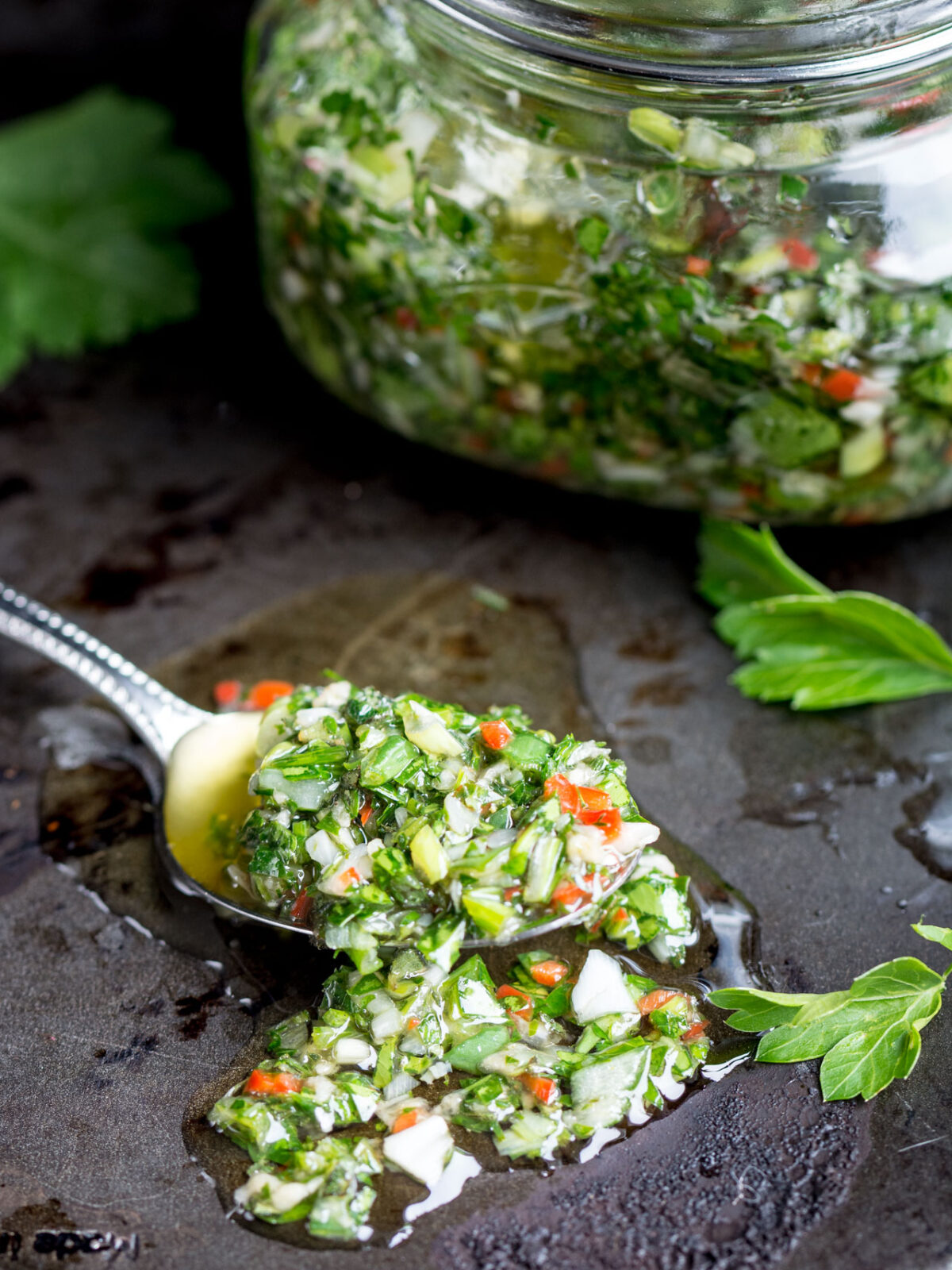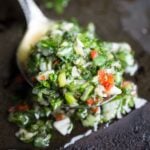This easy chimichurri recipe is bright and zesty, with ingredients like fresh herbs, vinegar, oil, and garlic, making the base of the no-cook sauce. It’s a healthy versatile vegan and gluten-free topping that can be used on everything from meat to vegetables!

Chimichurri is a robust and fragrant sauce that adds a tangy and spicy element to savory dishes. Since the ingredients are not cooked, the finished product has potent garlic, herb, and vinegar notes.
It’s incredibly versatile and may be used as a marinade, finishing sauce, or salad dressing. Chimichurri is a great way to add flavor to many meat, poultry, fish, and vegetable dishes.
In this recipe, heart-healthy olive oil, fresh herbs, and garlic have numerous health benefits, including anti-inflammatory and antioxidant properties. Chimichurri can also be a replacement for other sauces that are traditionally higher in fat, sugar, and sodium, like steak sauce or barbecue sauce.
This quick and easy chimichurri recipe will soon become your new favorite condiment!
What is Chimichurri?
Chimichurri is a bright, flavorful, uncooked sauce made from fresh herbs, garlic, oil, and vinegar. Many recipes also include peppers, citrus juice, and onion to add extra flavor and spice. The finished product is acidic, herby, and spicy.
Chimichurri is typically made by pulsing ingredients together in a food processor or finely chopping them, and there are many substitutions and variations of this simple yet tasty recipe.
It originated in Argentina, where it’s traditionally served with grilled meat dishes or asados. In addition, chimichurri may also be used as a topping for roasted sausages, poultry, or fish.
Key Ingredients
Parsley. This is the dominant herb flavor of the dish, so it’s important to use fresh, not dried, parsley. Italian flat-leaf parsley is more flavorful and is better for this recipe than the milder curly parsley, though either would be acceptable.
Parsley is a rich source of vitamin K, which is beneficial for bone health and blood clotting. It also contains antioxidants and other essential vitamins and minerals.
Garlic. Since the garlic in this recipe is uncooked, it provides a more intense flavor and greater health benefits than cooked garlic. The active compound in garlic (which is reduced by cooking) can help immune function and may play a role in heart, metabolic, and brain health.
Red Chili. Though optional, this ingredient is recommended if you like spice! You can reduce the spice level by removing the seeds and veins from the chili. If you prefer a spicier sauce, look for smaller, riper red chilis, which will bring more heat.
Red chilis contain the compound capsaicin, which boasts many health benefits, including being anti-inflammatory and rich in vitamins, minerals, and antioxidants. It may also reduce the risk of heart disease.
Olive Oil. Extra virgin olive oil adds a smooth, rich flavor to the chimichurri. The fat in olive oil helps your body absorb fat soluble vitamins from the herbs, like vitamin K. It’s also a heart-healthy fat that can help lower high cholesterol levels. Olive oil’s antioxidant and anti-inflammatory properties make it a highly nutritious ingredient in this dish.
Red Wine Vinegar. The vinegar in this recipe provides an acidity to balance out the herbs and the spice. Red wine vinegar is rich in antioxidants and may be beneficial for heart health and blood sugar management.

How to Make Chimichurri
All you need is five minutes to make this zingy, fresh, flavorful chimichurri sauce!
- Finely chop the herbs, the red chili, and the spring onion. Mince the garlic. You can deseed and devein the chili if you prefer less heat.
- Combine the chopped ingredients in an airtight container with the olive oil, red wine vinegar, lime juice, salt, and pepper.
- Shake well to combine. You can enjoy right away, or let the chimichurri marinate for a few hours to build flavor.
Recipe Tips
Finely chop the herbs. By finely chopping the herbs, you allow them to release all the wonderful flavor from inside the leaves, creating a much more powerful finished product. It’s also helpful to chop all of the ingredients a similar size so your sauce has a uniform texture without big chunks of any one ingredient.
Don’t have red wine vinegar? White wine vinegar is an acceptable substitute in this recipe if you’re out of red wine vinegar. Other vinegars, like rice vinegar or apple cider vinegar, may impart too strong of a flavor on the chimichurri.
Use a food processor! If you want to make this recipe even faster, try pulsing all the ingredients together in a food processor. The final texture should be chunky, not fully pureed.
Can’t find spring onions? You can substitute green onions or shallots if you’re unable to find spring onions in the grocery store.

Frequently Asked Questions
How long does chimichurri last?
Chimichurri stays good for up to a week when stored in an airtight container in the fridge. The flavors will get stronger the longer the sauce marinates, which is a benefit.
You can also freeze chimichurri, which is a great option if you have lots of fresh herbs on hand you don’t want to waste. Try freezing it in an ice cube tray so you have single-serve portions ready to defrost. Once it’s frozen, transfer to an airtight freezer bag for up to three months. When you’re ready to enjoy, put the desired amount of cubes into a container in the fridge and let it defrost overnight.
Can you make chimichurri with cilantro?
Yes! You can absolutely use cilantro in chimichurri sauce. Depending on the type of cuisine you’ll be serving your sauce with, you can experiment with other herbs as well, like basil, mint, and thyme.
Where to buy chimichurri sauce?
Many grocery stores sell premade chimichurri sauce, and it’s sold in either a shelf-stable jar in the condiment aisle or with the refrigerated dips and sauces. You can also buy dry chimichurri spice rub, which contains dried herbs and spices, to season your meat or vegetables before cooking.
Are chimichurri and pesto the same thing?
Though both made with fresh herbs, garlic, and olive oil, chimichurri and pesto have completely different flavor profiles. Pesto is made primarily with basil, pine nuts, and parmesan cheese. It does not have the same acidic and spicy flavor as chimichurri. Chimichurri is made with different herbs as well, typically parsley and oregano.
What to Eat with Chimichurri
This chimichurri sauce recipe makes a great finishing sauce for meat, especially steak and other grilled proteins like shrimp and chicken. You can also use it to coat vegetables before roasting, add extra oil and vinegar to use it as a salad dressing, or toss with with pasta.
Looking for other ways to serve chimichurri? Try some of our favorites!
- Chimichurri Fajitas– Steak tacos with roasted vegetables and chimichurri sauce.
- Savory Yogurt Salad– Delicious and fresh salad with creamy yogurt, spicy chickpeas, and chimichurri sauce.
Easy Chimichurri Recipe
Ingredients
- 1 fresh parsley large bunch (about 1/2 cup finely chopped)
- 2 tbsp oregano finely chopped
- 5 cloves garlic minced
- 1 spring onion finely chopped
- 1/2 cup olive oil
- 2 tbsp red wine vinegar
- 1 squeeze Lime Juice
- salt and pepper to taste
Instructions
- Finely chop the herbs, the chili, and the spring onion. Mince the garlic.
- Combine the chopped ingredients with the olive oil, red wine vinegar, lime juice, salt, and pepper in an airtight container.
- Shake well to combine. Enjoy right away or let marinate for a few hours to let the flavors develop.
Nutrition
Images by Lauren Caris Short.







